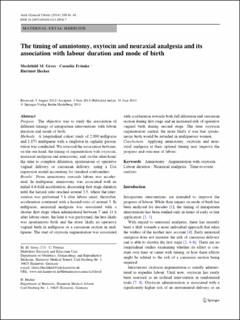Please use this identifier to cite or link to this item:
https://doi.org/10.21256/zhaw-4286| Publication type: | Article in scientific journal |
| Type of review: | Peer review (publication) |
| Title: | The timing of amniotomy, oxytocin and neuraxial analgesia and its association with labour duration and mode of birth |
| Authors: | Gross, Mechthild Maria Frömke, Cornelia Hecker, Hartmut |
| DOI: | 10.21256/zhaw-4286 10.1007/s00404-013-2916-7 |
| Published in: | Archives of Gynecology and Obstetrics |
| Volume(Issue): | 289 |
| Issue: | 1 |
| Page(s): | 41 |
| Pages to: | 48 |
| Issue Date: | 2014 |
| Publisher / Ed. Institution: | Springer |
| ISSN: | 0932-0067 1432-0711 |
| Language: | English |
| Subjects: | Analgesia; Epidural analgesia; Cesarean section; Cohort studies; Labor onset; Induced labor; Obstetric labor; Longitudinal study; Oxytocic; Pain management; Parturition; Pregnancy; Treatment outcome; Obstetric delivery; Extraembryonic membranes |
| Subject (DDC): | 618.4: Childbirth |
| Abstract: | Purpose: The objective was to study the association of different timings of intrapartum interventions with labour duration and mode of birth. Methods: A longitudinal cohort study of 2,090 nulliparae and 1,873 multiparae with a singleton in cephalic presentation was conducted. We assessed the association between, on the one hand, the timing of augmentation with oxytocin, neuraxial analgesia and amniotomy, and, on the other hand, the time to complete dilatation, spontaneous or operative vaginal delivery or caesarean delivery, using a Cox regression model accounting for standard confounders. Results: From amniotomy onwards labour was accelerated. In multiparae, amniotomy was associated with an initial 6.6-fold acceleration, decreasing first stage duration until the hazard ratio reached around 3.5, where the intervention was performed 5 h after labour onset; thereafter, acceleration continued with a hazard ratio of around 3. In nulliparae, neuraxial analgesia was associated with a shorter first stage when administered between 7 and 11 h after labour onset; the later it was performed, the less likely was spontaneous birth and the more likely an operative vaginal birth in nulliparae or a caesarean section in multiparae. The start of oxytocin augmentation was associated with acceleration towards both full dilatation and caesarean section during first stage and an increased risk of operative vaginal birth during second stage. The later oxytocin augmentation started, the more likely it was that spontaneous birth would be retarded in multiparous women. Conclusions: Applying amniotomy, oxytocin and neuraxial analgesia at their optimal timing may improve the progress and outcome of labour. |
| Further description: | Erworben im Rahmen der Schweizer Nationallizenzen (http://www.nationallizenzen.ch) |
| URI: | https://digitalcollection.zhaw.ch/handle/11475/8169 |
| Fulltext version: | Published version |
| License (according to publishing contract): | Licence according to publishing contract |
| Restricted until: | 2019-01-01 |
| Departement: | School of Health Sciences |
| Organisational Unit: | Institute of Midwifery and Reproductive Health (IHG) |
| Appears in collections: | Publikationen Gesundheit |
Files in This Item:
| File | Description | Size | Format | |
|---|---|---|---|---|
| 2014_Gross_TheTimingOfAmniotomyOxytocinAn.pdf | Verfügbar im Rahmen der Schweizer Nationallizenzen (http://www.nationallizenzen.ch) | 322.25 kB | Adobe PDF |  View/Open |
Show full item record
Gross, M. M., Frömke, C., & Hecker, H. (2014). The timing of amniotomy, oxytocin and neuraxial analgesia and its association with labour duration and mode of birth. Archives of Gynecology and Obstetrics, 289(1), 41–48. https://doi.org/10.21256/zhaw-4286
Gross, M.M., Frömke, C. and Hecker, H. (2014) ‘The timing of amniotomy, oxytocin and neuraxial analgesia and its association with labour duration and mode of birth’, Archives of Gynecology and Obstetrics, 289(1), pp. 41–48. Available at: https://doi.org/10.21256/zhaw-4286.
M. M. Gross, C. Frömke, and H. Hecker, “The timing of amniotomy, oxytocin and neuraxial analgesia and its association with labour duration and mode of birth,” Archives of Gynecology and Obstetrics, vol. 289, no. 1, pp. 41–48, 2014, doi: 10.21256/zhaw-4286.
GROSS, Mechthild Maria, Cornelia FRÖMKE und Hartmut HECKER, 2014. The timing of amniotomy, oxytocin and neuraxial analgesia and its association with labour duration and mode of birth. Archives of Gynecology and Obstetrics. 2014. Bd. 289, Nr. 1, S. 41–48. DOI 10.21256/zhaw-4286
Gross, Mechthild Maria, Cornelia Frömke, and Hartmut Hecker. 2014. “The Timing of Amniotomy, Oxytocin and Neuraxial Analgesia and Its Association with Labour Duration and Mode of Birth.” Archives of Gynecology and Obstetrics 289 (1): 41–48. https://doi.org/10.21256/zhaw-4286.
Gross, Mechthild Maria, et al. “The Timing of Amniotomy, Oxytocin and Neuraxial Analgesia and Its Association with Labour Duration and Mode of Birth.” Archives of Gynecology and Obstetrics, vol. 289, no. 1, 2014, pp. 41–48, https://doi.org/10.21256/zhaw-4286.
Items in DSpace are protected by copyright, with all rights reserved, unless otherwise indicated.